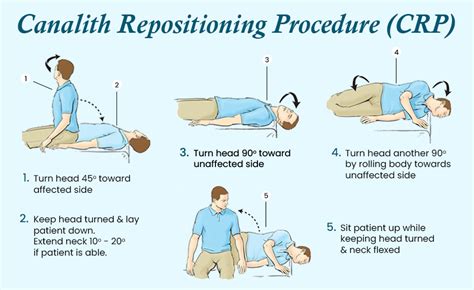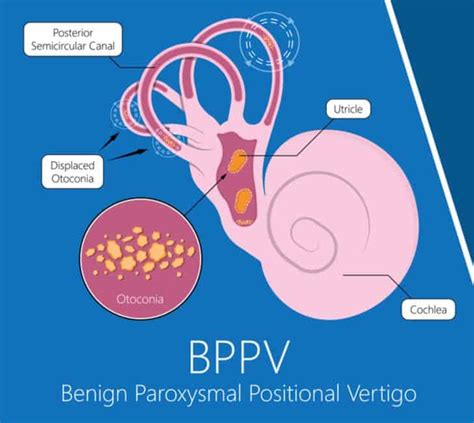Intro
Discover 5 effective ways to treat Benign Paroxysmal Positional Vertigo (BPPV), including exercises, maneuvers, and lifestyle changes to alleviate vertigo symptoms, dizziness, and balance disorders, and find relief from inner ear problems.
Benign paroxysmal positional vertigo, commonly referred to as BPPV, is a condition related to the inner ear that affects balance and causes vertigo. This condition occurs when tiny crystals in the inner ear become dislodged and move into the semicircular canals, which are filled with fluid. The movement of these crystals causes the inner ear to send false signals to the brain, leading to a spinning sensation and other symptoms associated with vertigo. Understanding the importance of treating BPPV is crucial for managing symptoms and improving quality of life.
The symptoms of BPPV can be quite debilitating, including dizziness, nausea, vomiting, and a loss of balance. These symptoms can significantly impact daily activities, making it essential to seek medical attention for proper diagnosis and treatment. Fortunately, BPPV is treatable, and various methods can help alleviate symptoms and restore balance. The treatment options for BPPV have evolved over time, and healthcare professionals now have a range of techniques to manage the condition effectively.
The primary goal of treating BPPV is to relieve symptoms, improve balance, and prevent future episodes. Healthcare professionals use a combination of diagnostic tests and treatment methods to achieve this goal. Diagnostic tests, such as the Dix-Hallpike test, help identify the affected ear and the specific canal involved. Once diagnosed, treatment can begin, and patients can expect significant improvement in their symptoms. The treatment of BPPV has become more sophisticated, with a focus on non-invasive and minimally invasive procedures that offer quick relief and long-term benefits.
Understanding BPPV and Its Causes

Diagnosis and Treatment Options

Canalith Repositioning Procedures
Canalith repositioning procedures, such as the Epley maneuver, are commonly used to treat BPPV. These procedures involve a series of movements that help to relocate the dislodged crystals to their normal position in the inner ear. The Epley maneuver is a non-invasive procedure that can be performed in a healthcare professional's office. It involves a series of movements, including rolling onto the affected side, sitting up, and lying down, to help relocate the crystals.Treatment Methods for BPPV

- Canalith repositioning procedures, such as the Epley maneuver
- Vestibular rehabilitation therapy
- Medication, such as antihistamines and anti-nausea medication
- Surgery, in severe cases where other treatment options have failed
Vestibular Rehabilitation Therapy
Vestibular rehabilitation therapy (VRT) is a type of physical therapy that helps to improve balance and reduce symptoms of vertigo. VRT involves a series of exercises and movements that help to strengthen the vestibular system and improve communication between the inner ear and the brain. This type of therapy can be beneficial for patients with BPPV, as it helps to improve balance and reduce the risk of falls.Benefits of Treatment

- Relief from symptoms, such as vertigo and dizziness
- Improved balance and reduced risk of falls
- Increased mobility and ability to perform daily activities
- Reduced risk of future episodes
Prevention and Self-Care
Prevention and self-care are essential for managing BPPV and reducing the risk of future episodes. Patients can take several steps to prevent BPPV, including:- Avoiding heavy lifting and bending
- Avoiding sudden movements
- Getting regular exercise to improve balance and strength
- Managing stress and anxiety
Living with BPPV

Coping with Symptoms
Coping with symptoms of BPPV can be challenging, but there are several strategies that can help. Patients can try:- Resting and avoiding strenuous activities
- Avoiding sudden movements
- Getting regular exercise to improve balance and strength
- Managing stress and anxiety
Conclusion and Next Steps

We invite you to share your experiences and thoughts on BPPV in the comments section below. If you have any questions or concerns, please do not hesitate to reach out. You can also share this article with friends and family who may be experiencing symptoms of BPPV.
What is BPPV and how is it diagnosed?
+BPPV is a condition related to the inner ear that affects balance and causes vertigo. It is diagnosed using a combination of medical history, physical examination, and diagnostic tests, such as the Dix-Hallpike test.
What are the treatment options for BPPV?
+The treatment options for BPPV include canalith repositioning procedures, vestibular rehabilitation therapy, and medication. In some cases, surgery may be necessary.
How can I prevent future episodes of BPPV?
+Patients can take several steps to prevent future episodes of BPPV, including avoiding heavy lifting and bending, avoiding sudden movements, getting regular exercise to improve balance and strength, and managing stress and anxiety.
